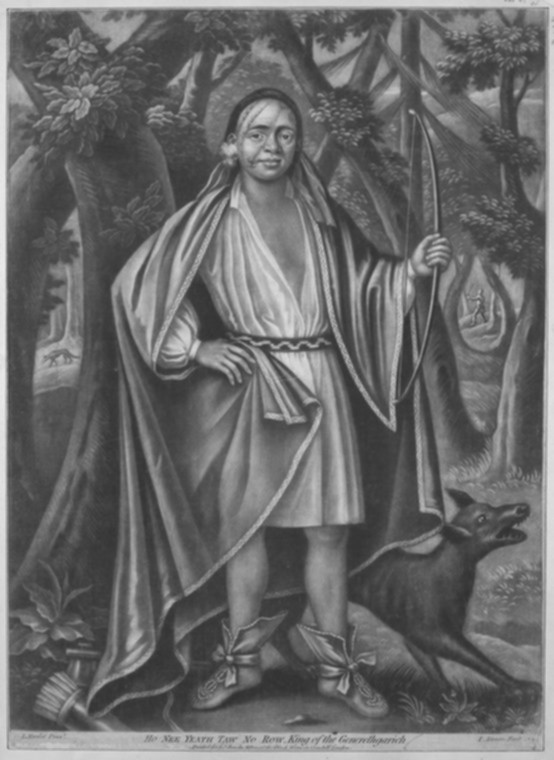In the image below the red outline around this relief map is the upper extent of the lands of the Warranawonkong. This line encloses the blue creeks that drain the Catskill escarpment and the eastern slope of the Catskill piedmonts into the Hudson river.
On this map the interior lines mark treaty and purchase lands and the boxes of text inside them tell of how and when these purchases happened.
The odd Indian names placed on areas of this map were actually used extensively by the early colonists. The name Esopus was used for this part of the Hudson Valley until well after the Revolution. Atharacton meant Great Field and was the main plantation of the native peoples far before the arrival of Europeans.
Below the PDF is a composition that covers the history of the demise of these people that Henry Hudson called "Loving People"
This is a web production of Michael Sullivan Smith. It's distributed free of commercial or government platforms from the Cloud. If you find it informative you may be a patron by visiting the Patreon.com link on this introduction page. There you will find a list of interesting creations such as this to add to your electronic collection.The file burns a lot of bandwidth every time it is pulled down from the cloud. Patrons help me pay for this service so that you can save this file from the cloud into your computer. The PDF from this streaming file can be downloaded to your computer. The only good thing to come out of commercial dominance of the Internet is the power it needed in your personal computer to pull off this dominance. Please use what you have and save energy. Save the PDF to your computer if you're going to study this file.
Decline and Disappearance of the Warranawonkong
|
The main cause of the Second Esopus War and the massacre that initiated it was festering resentment over a haughty statement by the Maquas in January of 1661 that they would pass to the South River on this pathway and make war on the Esopus Indians if prevented. The Dutch had heavily armed the Maqua forest Indians to protect their fur trade and refused to arm the Lenni Lenape federation's agrarian peoples. The Warranawonkong were always the protectors of the Hudson River terminus of the great pathway of the Lenni Lenape people. Their primary council fire was with the Lenni Lenape and this was on the South (Delaware) River. Removal of the Dutch from their territory because they facilitated Maqua access to this path was a duty to their “Nation”. This Dutch presence on the Great Path signified that all of the Lenni Lenape people were dominated by the Maquas.
In the final analysis it was not war with the Dutch or these allies that wiped out the Warranawonkong. They had few military encounters with this highly populace, war-trained race. Rather, it was with the help of Maqua informants that the Dutch sought out and destroyed the winter stores of the Esopus, Rondout and Wallkill Warranawonkong plantations in the Second Esopus War. That left those that depended on these supplies to starve and in a weakened state the entire federation become easy prey for the Maquas.
|
At the end of each of the Esopus wars more and more Indian land was ceded “by conquest” to the Government of New Netherlands until there was little good land between New Paltz and Saugerties that the Warranawonkong were allowed by their conquerors to cultivate. As this agrarian people was forced to retreat to the mountain valleys they rapidly lost their standing of dominance and the Maquas of the north subjugated them. The last of their greatness was recorded with the presence in 1705 of a Minsi "king" representing their interests to Queen Anne as part of the Mohawk council's visit to England (shown here in a painting by the court painter). But by this time they were a tribute people with their identity well on its way to being completely lost. The Council Fire of the Lenni Lenape Nation had been extinguished. Even the most remote ceded lands at the Esopus, Wallkill and Plattekill headwaters had been divided among the Dutch and later English farmers and soldiers so that there was not an unoccupied place for them to visit for attending to their traditional rituals to honor their long husbandry of their lands.
It is said that well into the late 19th century a single Indian would appear and camp every year between the planting and harvest times wherever allowed on the strand at the Rondout. At times it was an old squaw with a young male. The reason was unknown at that time but was likely the fulfillment of a combination of deep-set religious ritual and a treaty obligation.
At the end of the Second Esopus War the terms of the Warranawongkong treaty with the Dutch were confirmed by the English in the Nicolls Treaty because they had seized the Dutch colony at the same time. This English treaty required that an Esopus Indian elder, with some chosen youth of the people to witness, appear and reaffirm the peace each year at Wiltwyck, newly renamed Kingston. A dwelling place for the Indians to house themselves on the strand was to be provided by this treaty “over the kil, where they can remain”. It is recorded that a hundred years after the original treaty a destitute band of Indians living among the Mohawks asked for help from the government to cover the expense of their journey to Kingston to fulfill this treaty obligation. The Indian visitors that appeared over a hundred years after that may have been from some remote remnant of this presumably extinguished race still faithfully fulfilling this annual pilgrimage out of honor, timed as part of a ritual process of renewal, but unremembered by their negligent conqueror.
|
 Two major Indian wars were fought in the Esopus between 1659 and 1664 as the European settlers and their fields spread. It was not the sharing of land that caused the problems. The horses, cows and hogs of the settlers in the open Indian fields, the settlers' fencing good land and not planting it and the building of the village stockade directly atop the pathway of the ancient Indian trade route did stress the Indian's sense of fairness and reverence for their land and traditions. Rather, relative to the ancient trade route, the primary cause of the wars was the friendship of the Dutch with the Maquas (Mohawks) and their accepting visits from them and inviting them to travel on this pathway over the lands of the Lenni Lenape's Minsi peoples.
Two major Indian wars were fought in the Esopus between 1659 and 1664 as the European settlers and their fields spread. It was not the sharing of land that caused the problems. The horses, cows and hogs of the settlers in the open Indian fields, the settlers' fencing good land and not planting it and the building of the village stockade directly atop the pathway of the ancient Indian trade route did stress the Indian's sense of fairness and reverence for their land and traditions. Rather, relative to the ancient trade route, the primary cause of the wars was the friendship of the Dutch with the Maquas (Mohawks) and their accepting visits from them and inviting them to travel on this pathway over the lands of the Lenni Lenape's Minsi peoples.